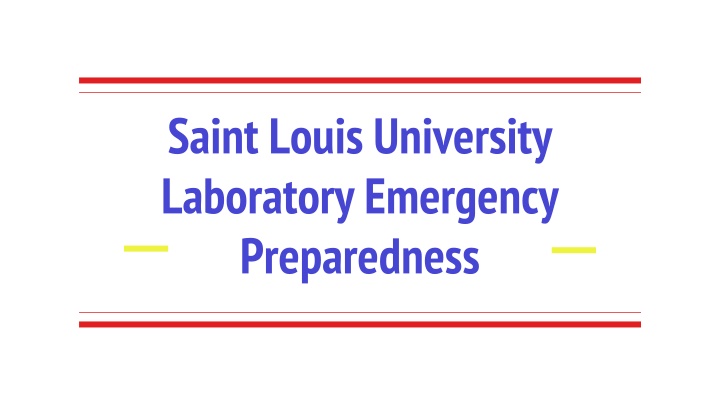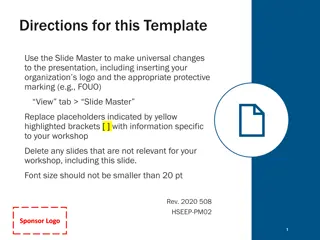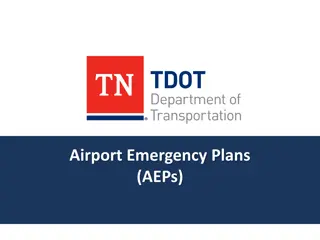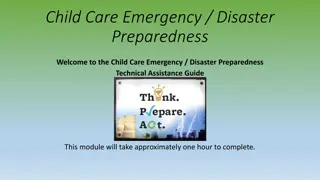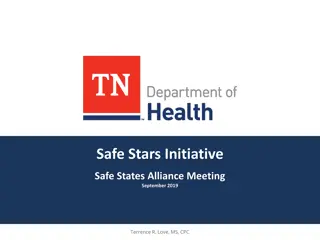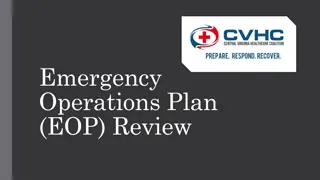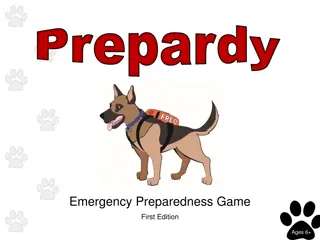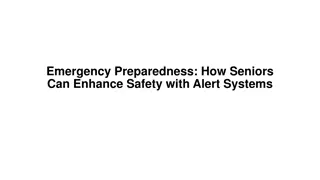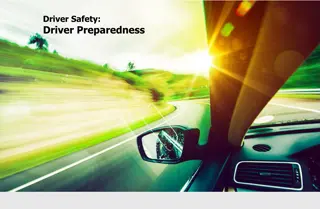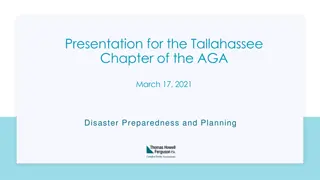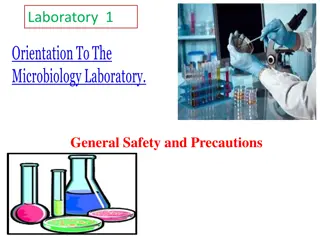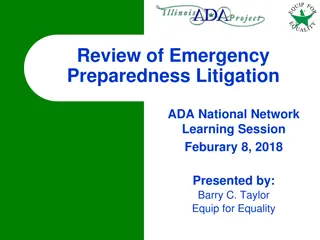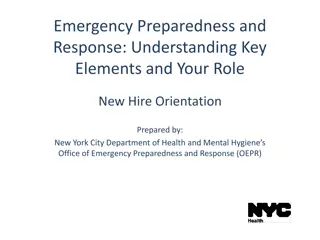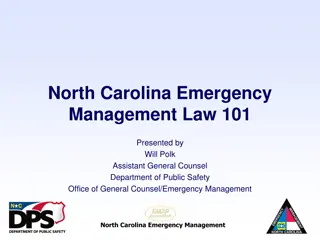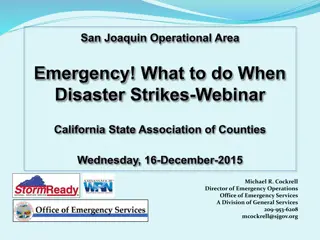Laboratory Emergency Preparedness and Safety Measures
Understanding the importance of laboratory emergency preparedness to ensure safety in various scenarios like severe weather, floods, winter weather, earthquakes, and fires. Proper procedures and individual responsibility play a crucial role in minimizing risks and enhancing recovery in emergencies.
Download Presentation

Please find below an Image/Link to download the presentation.
The content on the website is provided AS IS for your information and personal use only. It may not be sold, licensed, or shared on other websites without obtaining consent from the author.If you encounter any issues during the download, it is possible that the publisher has removed the file from their server.
You are allowed to download the files provided on this website for personal or commercial use, subject to the condition that they are used lawfully. All files are the property of their respective owners.
The content on the website is provided AS IS for your information and personal use only. It may not be sold, licensed, or shared on other websites without obtaining consent from the author.
E N D
Presentation Transcript
Saint Louis University Laboratory Emergency Preparedness
Why Is Laboratory Emergency Preparedness Important? Knowing what to do before an emergency occurs can make the difference between life and death or serious injury. Emergencies can occur at any time and without warning, but their effects can be minimized and recovery can be improved if proper emergency procedures are established and followed. Emergency preparedness is also an individual responsibility.
Severe Weather Thunderstorm and Lightning: Remain calm. Close window blinds; stay away from windows. Additionally, for tornadoes: Move quickly to an interior hallway on the lowest level, an interior stairwell, crouch near the floor or under heavy, well-supported objects and cover your head. Do not use elevators. Do not leave the building until instructed to do so.
Floods Floods caused by domestic or research lab water systems do not normally endanger people directly, but can pose risk of electrical shock if caution is not exercised. Floods caused by overflow of rivers or backed-up storm sewer systems are dangerous and may require building evacuation. Call DPS at 314-977-3000 to report flooding. Avoid walking through flooded areas in buildings. Never drive through a water covered roadway and be alert for rising, swift moving water.
Winter Weather Extreme winter weather conditions may trigger electrical power outages, in addition to obvious health risks associated with extreme cold temperatures, ice, and snow storms. Avoid scheduling experiments involving significant hazards if extreme winter weather is imminent. If rescheduling is not possible, minimize the duration of the experiment. Be prepared for electrical power outages. University closures can be checked by calling SLU s Snowline: (314) 977-SNOW (314-977-7669).
Earthquakes Seek cover under a desk, table or other heavy furniture. Brace yourself in a doorway in a position that the door will not hit you. Move against an interior wall, kneel or sit, and cover yourself. Avoid broken glass, electrical wires, unstable debris or equipment. Aftershocks may occur, so continue to be alert and prepared to seek cover.
Fire Stay calm and safely follow an evacuation route upwind from the fire. Do not use elevators. Know your emergency evacuation assembly area and wait for the all clear . Fire extinguishers: Know where they are located throughout the building. Use if a fire is small, under control, and you are comfortable using extinguisher. Know fire classification to operate the appropriate fire extinguisher.
Medical Emergency Remain calm and contact DPS (314-977-3000) or 911, if necessary. If trained, administer first aid, CPR, or AED. AEDs are located around campus, typically at front desks or near high traffic areas. DPS maintains a list of AED locations here. Man down system Alert system that detects falls and impacts, and sends an alert to DPS. Important tool for lone workers in A/BSL-3 laboratories.
Evacuation Areas & AED Locations - North Campus Building Reassembly Area Nearest AED Biomedical Engineering Grassy field at Olive & Theresa Wool Center, 1st floor across from elevator Interdisciplinary Science & Engineering (ISE) 1st floor near mechanical room 1M1 3rd floor near mechanical room 3M1 Soccer Practice Field Lecture Hall Hermann Stadium Bottom of the north stairs on right (Northeast wall, L1) Litteken Hall Grass area near Olive-Compton garage Tegeler, 1st floor (Northeast Wall) Macelwane Hall Hermann Stadium Front lobby McDonnell Douglas Hall Soccer Practice Field In lobby right of entrance (Southeast wall) Monsanto Hall Hermann Stadium Main lobby left of entrance (East wall) Ritter Hall Grass area on north side of building ISE, 1st floor & 3rd floor Shannon Hall Hermann Stadium Monsanto, main lobby left of entrance (East Wall)
Evacuation Areas & AED Locations - South Campus Building Reassembly Area Nearest AED Allied Health Medical School Field Lobby south entrance Caroline Building de Greeff Park LRC, next to security desk Doisy Hall de Greeff Park LRC, next to security desk Doisy Research Center (DRC) Hickory West Garage DRC front desk Schwitalla Hall de Greeff Park LRC, next to security desk
Utility Outage Electricity: Cease activities that involve potentially hazardous conditions. Evacuate the building immediately. Do not rely on emergency lighting as a means to continue working. Plan ahead to use E-power for vital equipment (red outlets). Contact DPS at 314-977-3000. Gas Leak: Stop ALL activities. Do not turn electrical switches, including lights, on or off. Do not use the phone inside of the building. Immediately evacuate the building using the nearest stairwell. Contact DPS at 314-977-3000 after exiting the building.
Active Shooter Run: Evacuate if possible Have a plan and use accessible escape path. Leave your belongings and help others if possible. Leave those who are not willing to evacuate. Keep hands visible, call 314-977-3000 or 911 when safe and follow instructions of any police officers. Hide: If you can t evacuate Find a place to hide where active shooter is less likely to find you; stay out of shooter s view. Lock doors, or blockade with furniture, and turn off the light. Do not trap yourself. If you can t speak call 911, but do not hang up. Fight: Take action against active shooter Fight as a last resort and only when your life is in imminent danger. Yell, act aggressive, and throw items at the shooter. Call DPS or 911 when it is safe to do so. Report any suspicious activities to DPS right away, such as if you know someone is carrying a firearm or planning an attack.
Sharps Injuries Wash the wound immediately with soap and water. Notify your supervisor immediately. If there is ANY risk of exposure to a biological agent, report immediately to Concentra Urgent Care or SSM Health Saint Louis University Hospital Emergency Department for treatment. If sharps may have been be contaminated, contact SLU Risk Management (314-977-2633) to record injury in the Sharps Injury Log. Follow care-provider recommendations for follow-up treatment. Notify the Biological Safety Officer at (314) 977-6888.
Biohazardous Spills Notify your supervisor immediately, if available, and DPS if necessary. Wearing appropriate PPE, cover spill with paper towels or disposable pads. Pour diluted disinfectant onto paper towels, working from outside the spill to the interior of the spill. Allow the disinfectant sufficient contact time (in accordance with label claim efficacy statement) to inactivate the material(s). If using a 1:9 concentration of freshly prepared bleach solution, allow for at least a 20-minute contact time. Pick up any broken glass with forceps and dispose in SHARPS container within room. Pick up paper towels and wipe the area again with an appropriate disinfectant. Place all contaminated materials, including PPE, in a biohazard bag for autoclaving or stericycle disposal. Wash hands thoroughly with soap and water after removing disposable gloves.
Chemical Spills In the event of skin or eye exposure, immediately flush the area with water for 15 minutes. Evacuate the immediate area of the spill and adjacent areas. Notify your supervisor and/or other employees in the area. Contact DPS at (314) 977-3000 to report the spill. Provide DPS with: The correct spelling of the chemical name. The volume of chemical spilled. The exact location of the spill, including building name and room number. A phone number at which you can receive a return phone call. Seek medical attention from Concentra Urgent Care or the SSM Health Saint Louis University Hospital Emergency Department, if necessary.
ALL Radioactive Spills - (See also Major or Minor) Full Emergency Procedures for Radioactive Materials document may be accessed here. 1. It is important to avoid the spread of contamination. a. Do not leave the immediate area. b. Immediately notify all persons in the area that you have just had a spill of radioactive material. c. Prevent the spread of contamination by limiting the movement of all personnel who may be contaminated. i. Place an absorbent pad or bench paper on the floor near any potentially contaminated persons for them to stand on. ii. If the spill involves significant activity, several sheets of bench paper may be placed on the floor to create a path to allow the person to move several feet away from the spill area without the risk of spreading contamination to other areas of the floor. d. Immediately survey all individuals who have been in the vicinity of the spill location. Especially important is to survey the soles of the shoes worn by these individuals to assure that the spill has been contained. Also, survey hands, lab coats, and other clothing. Prevent the spread of contamination by covering the known spill area with absorbent paper. Decontaminate personnel immediately a. If individuals are contaminated, follow procedures for personnel decontamination on page 2 of the full Emergency Procedures for Radioactive Materials . e. 2.
Radioactive Spills - Major Definition: A spill of greater than 100 Ci of any radionuclide or involving the floor or contaminated personnel. 3. Notify all persons not involved in the spill to vacate the room. a. Be sure to survey all individuals as they leave the room. b. Especially important is to survey the soles of the shoes worn by these individuals to assure that the spill has been contained within the room and is not spread outside of the room. c. Also, survey hands, lab coats, and other clothing. 4. Do not attempt to clean up the spill. To prevent the spread of contamination, limit the movement of all personnel who may be contaminated. 5. Shield the source if possible. This should be done only if it can be done without further spread of contamination or a significant increase in radiation exposure. 6. Prevent unauthorized entry by closing the door and placing a Caution: Contaminated Area sign or warning tape across the entrance. If possible, an individual who is not contaminated should be stationed outside of the door to prevent unauthorized entry until the spill team arrives. 7. Notify the Radioactive Spill Response Team immediately via DPS at (314) 977-3000. These procedures apply 24 hours a day, 7 days a week.
Radioactive Spills - Minor Definition: A spill of 100 Ci or less of any radionuclide confined to a bench top or other laboratory surface, and not involving the floor or contaminated personnel. 3. Clean up the spill using disposable gloves and absorbent paper. Carefully fold the absorbent paper with the clean side out and place in a plastic bag for transfer to a radioactive waste container. Also put contaminated gloves and any other contaminated disposable material in the bag. 4. Survey the area with an appropriate radiation detector with a low range survey meter. Check the area around the spill. Also check your hands, clothing, and shoes for contamination. 5. Report the incident to the Radiation Safety Office at (314) 977-8609. If after hours or on a weekend, contact the Radiation Safety Officer through DPS at (314) 977-3000. This applies 24 hours a day, 7 days a week. 6. Document all survey results and cleanup efforts in a written report. Forward a copy of the written report to the Radiation Safety Officer. Keep a copy of the written report on file with the laboratory Radiation Safety Survey Records.
Summary Please complete the Safety Awareness Quiz on Emergency Preparedness by April 30, 2023. More information about campus emergency preparedness can be found here.
